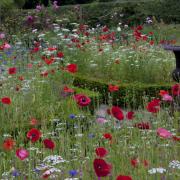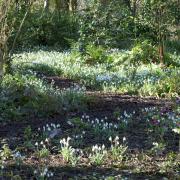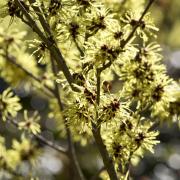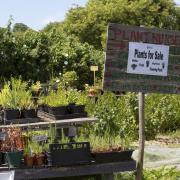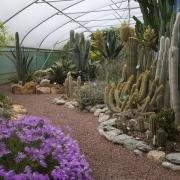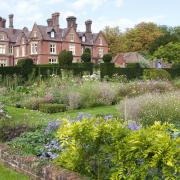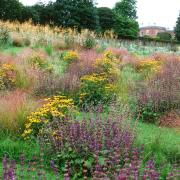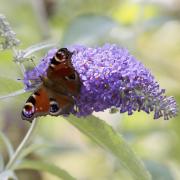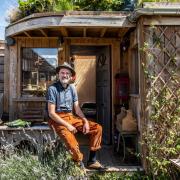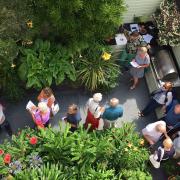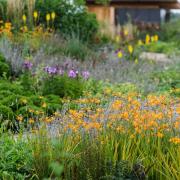Catch up with the Butcher family at their Langton Green allotment plot for the second of our four-part series following a year in the life of an allotment
Kent Life’s allotment family in Spring
Catch up with the Butcher family at their Langton Green allotment plot for the second of our four-part series following a year in the life of an allotment
After the quiet lull of winter, the main sowing season gets underway in spring as the soil begins to warm up. Spring sunshine and showers speed growth, so it’s time to get busy on the plot.
Visits to the allotment increase to at least three times a week for Russell, Louize, Chloe and Cameron. Excitement builds at the start of the gardening season, with plans for the year and new things to grow.
“It’s always a good time to meet others and possibly newcomers to offer advice and even receive advice,” says Russell. The days are starting to get longer and the weather improving, making it a joy to spend more time outdoors. “It’s great to see things growing, however this is also the time when pests begin to appear and as the allotment is organic often produce needs to be ‘cleaned’ by hand.”
This is certainly the busiest time on the allotment, with lots of jobs to catch up on as well as all the planting. Ground needs to be prepared, weeding begins and there are a number of maintenance tasks, such as the cold frame for the chillies, placing supports for the climbers or repairs to the raised beds from weather damage.
“It’s a simple case of everyone mucking in together. The children usually get 1p a weed and can earn �2 in a morning,” says Russell.
The weather can continue to be changeable at this time of the year, adding to the challenges. Frosts can continue, even snow, which can damage emerging crops. Russell is always ready to apply protection with fleece or newspaper.
Winter cold, such as all the snow we have had this year, is a good thing as it kills off many of the pests and makes brassicas and parsnips taste better, however in spring it can be more problematic.
Warm soils and spring rains will mean good germination for outside sowing and young plants. A close eye needs to be kept on weather reports, especially towards the end of spring when putting out the more tender veg.
From experience gained over the past two years of having the allotment, Russell has a better idea of what crops do best in the conditions, as well as what the family likes to eat. Firm favourites include strawberries, sweetcorn, courgettes, salads, chillies and blackberries.
“We also like to move away from more conventional crops and focus on newer ideas such as the five kiwi plants I have planted, after my father’s success with them in Crowborough,” explains Russell.
Sowing and planting will continue through spring and into summer, starting with mostly root crops, such as early carrots, through to spring onions, lettuces, runner beans, sweet corn and herbs. Some are sown directly into the soil on the allotment, others raised in trays and then the seedlings transplanted.
As well as sowing and planting out, other spring jobs include mulching, feeding some of the crops and netting fruiting bushes to stop deer, rabbits and pigeons from eating the new shoots.
April and May are traditionally known as the ‘hungry gap’ as the winter crops come to an end and the first crops are not ready yet for harvesting, so this is not a time of rich pickings.
There are, however, spring cabbages, lettuces, onions and garlic to enjoy in April with spring onions, radishes, broad beans, peas, baby carrots and the first potatoes to look forward to in May. The first fruits are especially anticipated – rhubarb and of course strawberries from June.
Grow you own
To find out more about allotments in your area, contact your local council and get on a waiting list for next year of there are no plots left for this. For news on more gardens in Kent, visit kent.greatbritishlife.co.uk
April jobs in the allotment prepare soil weeding begins in earnest watch weather forecasts, keep fleece on standby for cold weather sow summer crops, such as peas, beans, beetroot, carrots, spring onions, sweetcorn and lettuce varieties sow herbs, such as parsley, fennel, oregano and thyme plant onion sets plant main crop potatoes sow tomatoes in greenhouse or cold frame strawberries can be planted out, remove flowers in the first year for larger crops in subsequent years hand pollinate peaches and nectarines a layer of compost mulch around base of fruit trees will ensure nutrition mulch and water newly planted fruit trees be on pest alert, prevention and protection, netting, covering, cleaning place supports/canes in place for runner beans and other climbers Russell’s budget-busting ideas Don’t overspend. The snow has caused havoc to many allotment holders who constructed overhead cages which, unfortunately, were severely damaged by the sheer weight of the snow I made a cold frame from an old pine bed for a grand total of �6 Save old plastic milk bottles to be used as collars for new seedlings Use old grapefruit halves as environmentally friendly slug catchers Dissuade aphids by spraying with diluted soapy water



